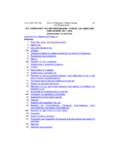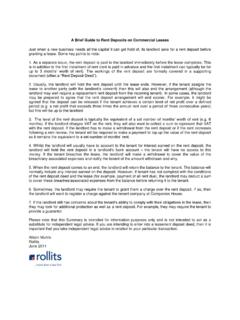Transcription of A brief on VAT (Value Added Tax) - Kannada Version
1 a brief on vat ( value Added Tax) What is VAT? VAT is a multi-stage tax levied at each stage of the value addition chain, with a provision to allow input tax credit (ITC) on tax paid at an earlier stage, which can be appropriated against the VAT liability on subsequent sale. VAT is intended to tax every stage of sale where some value is Added to raw materials, but taxpayers will receive credit for tax already paid on procurement stages. Thus, VAT will be without the problem of double taxation as prevalent in the earlier Sales tax laws. Presently VAT is followed in over 160 countries. The proposed Indian model of VAT will be different from VAT, as it exists in most parts of the world.
2 In India, VAT has replaced the earier State sales tax system. One of the many reasons underlying the shift to VAT is to do away with the distortions in our earier tax structure that carve up the country into a large number of small markets rather than one big common market. In the earlier sales tax structure tax is not levied on all the stages of value addition or sales and distribution channel which means the margins of distributors/ dealers/ retailers at large not subject to sales tax earlier. Thus, the sales tax pricing structure needs to factor only the single-point levy component of sales tax and the margins of manufacturers and dealers/ retailers etc, are worked out accordingly.
3 Internal trade and impeded development of a common market. prices by an amount higher than what accrues to the exchequer by way of revenues from it. Also, there was the problem of multiplicity of rates. All the states, provided for plethora of rates. These range from one to 25 per cent. This multiplicity of rates increases the cost of compliance while not really benefiting revenue. Heterogeneity prevailed in the structure of tax as well. Apart from general sales tax, most states used to levy an additional sales tax or a surcharge. In addition, the states levied luxury tax as also an entry tax on the sale of imported goods. All these practices of heterogeneity in structure as well as rates cause diversion of trade as well as shifting of manufacturing activity from one State to another.
4 Further, widespread taxation of inputs relates to vertical integration of firms, , the earlier system of taxes militated against ancillary industries and encourages them to produce more and more of the inputs needed rather than purchase them from ancillary industries. The earlier system of commodity taxes is non-neutral. It interferes with the producers' choice of inputs as well as with the consumers' choice of consumption, thereby leading to severe economic distortions. How can VAT address these issues: Under the VAT regime, due to multi-point levy on the price including value additions at each and every resale, the margins of either the re-seller or the manufacturer would be reduced unless the ultimate price is increased.
5 VAT would not cause cascading, nor would it cause vertical integration of firms. Also, it provides total transparency of the incidence of tax. This is because, VAT is a multi-stage sales tax levied as a proportion of the value Added . It is collected at each stage of the production and distribution process, and in principle, its burden falls on the final consumer. Another feature of VAT regime is discontinuation of the sales tax based incentives to new industrial units. Until now, all the states were granting such incentives to new industries in the form of exemption from tax on the purchase of inputs as well as on the sale of finished goods, sales tax loans and/or tax deferral.
6 However for the new industrial units to whom the incentive by way of exemption/ or tax deferrals are already sanctioned under the Sales Tax Act are continued in the form of refund. Rebating, returns & billing under VAT IN CASE OF MANUFACTURER (a) Input tax rebate is available only on the purchases made in the State of Karnataka and on the basis of 'Tax invoice' issued by the dealers selling goods to the manufacturers. Taxes or duties paid on other types of purchases namely: interstate purchases, interstate consignment receipt and International imports are not eligible for input tax rebate. (b) Output tax is to be charged and collected on the sales made in the State of Karnataka.
7 However, on the interstate sales taxes under CST Act could be collected separately or it could be included in the sale price also. In both these cases of sales, input tax rebate is available only on the purchases made in the State of Karnataka. On consignment transfer both in the State of Karnataka and interstate there is no levy of VAT or CST as there is no transaction of sale in either of them. (For interstate consignment of manufactured goods and the goods purchased from Karnataka and despatched to outside the State the dealer would be entitled for input rebate paid in excess of 2% on the local purchase). In case of export of the goods (both direct and indirect) the output tax is zero and input tax rebate is available only on the purchases made in the State of Karnataka.
8 (c) In the monthly return prescribed under VAT Rules namely Form VAT 100, the above types of purchases and sales are itemized. The dealer has to extract the details from the books of account and fill the return form. (d) The input tax rebate is taken while filing the VAT monthly return by reducing the output tax. For example: For a given month the input tax paid by a dealer is say ,000/- and the output tax payable is say ,000/-, then net-tax payable would be ,000/- (20,000 - 10,000). Please note that in the tax invoice, VAT is charged and collected on the entire output value . And in the bill of sale issued under interstate sales, CST could be collected separately or it could be included in the sale price also.
9 In case of direct and indirect exports no taxes are collected but the VAT paid on the locally purchased inputs is fully rebatable. IN CASE OF DISTRIBUTOR In case of distributors / wholesaler the conditions noted in para 1(a), (b), (c) &(d) above applies with the following modifications: Under para 1(b) the ''For interstate consignment of goods distributors / wholesaler would be entitled for input rebate paid in excess of 2% on the local purchase.'' IN CASE OF RETAILERS In case of retailers the conditions noted in para 1(a), (b), (c) &(d) above applies with the following modifications: Further the retailers within the turnover limit between 2-15 lakhs could opt for composition tax of 1% on their sales.
10 The condition prescribed to remain under composition scheme is apart from turnover limit, such dealer must not effect any interstate purchases (except a dealer executing works contract with certain conditions), must not claim any input tax rebate and must not collect output tax. Composition scheme under VAT Act Registration and payment of taxes under VAT Act can be of two types. First type is the registration and payment of taxes under full VAT and second type is the registration and payment of taxes under composition. The option should be exercised by a dealer, while applying for registration in the prescribed VAT Form 1.











